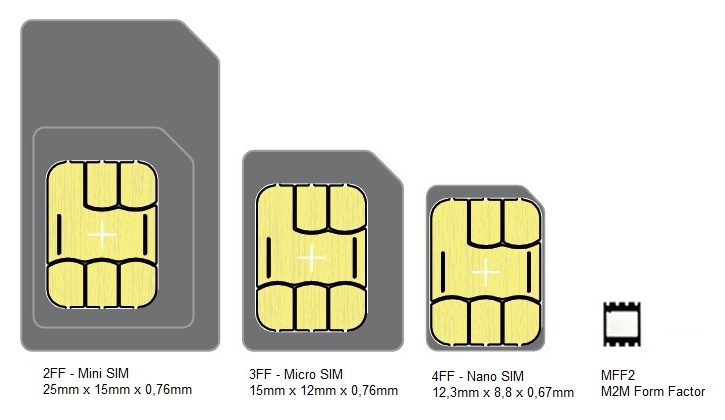eUICC (Embedded Universal Integrated Circuit Card) has been dubbed the next evolution of the SIM card, because it offers users the ability to change service provider over-the-air (OTA), without needing to physically change the embedded SIM card itself. eUICC represents the most radical change in over two decades of GSM connectivity, in terms of how customers can select and change service provider profiles based on the criteria or business rules of their choosing. Andy Brown reports.
eUICC definition and eUICC SIM advantages
When talking about eUICC, people often mistakenly associate it with a SIM form factor (MFF or M2M Form Factor, i.e. chip embedded SIM), but the real value of eUICC is not a hardware concept, it’s around the software in terms of how operator profiles (electrical SIM profiles) are managed. A traditional SIM is provisioned with a single profile that usually has 64KB or 128KB of memory. An eUICC eSIM (or MIM-Machine Identification Module) can host multiple profiles, features a very rich OS and requires a minimum memory of 512KB. While eUICC has been around for a number of years in areas such as the connected car market, it has lacked standardisation, making it difficult to change subscriptions over the air across a broad ecosystem of operators. It has become a more popular topic due to the growing popularity of embedded IoT devices and connected consumer electronics devices and, in particular, the Apple SIM, which is allowing consumers to switch from a set of providers, without needing to physically change the SIM card itself.


Andrew Brown, executive director of Enterprise and IoT Research at Strategy Analytics, recently spoke with Cyril Hullin, VP, Product Marketing, Cloud & Connectivity Services at Sierra Wireless the leading provider of IoT connectivity modules globally for six years running, according to Strategy Analytics. Hullin was a co-founder and CEO of MobiquiThings, a company at the forefront of IoT connectivity using multi-operator SIM cards, which was acquired by Sierra Wireless in June 2015.
AB: Cyril, eUICC has become a hot topic in 2016. What is the status of the eUICC technology/ market and why have we not seen much in the way of eUICC solutions yet?
CH: We are at a crossroads in terms of technology and markets. eUICC has really been around for at least four years. The GSMA, its carrier partners and carmakers were discussing how to bring multiple operator profiles effectively to the vehicle back in 2012. Up until now we have only really seen prestandard versions of eUICC, which we term GSMA versions 1 and 2. They lacked interoperability between SIM vendors, the operating systems of UICC, the infrastructure vendors, and vendors of eUICC subscription management nodes, such as Gemalto, G&D, Oberthur and Morpho.
Nevertheless, there have been around 20-30 million eUICC SIMS shipped globally, however, they do not really constitute true eUICC, in the sense that MNO profile swaps have not really happened because the technology was too immature. Several main issues hampered adoption of eUICC services:
- eUICC is still maturing as a standard and as a technology. Until recently the solutions on the market were based on the early GSMA v1 and v2 standards. These solutions were not very interoperable between SIMs and platforms, making it difficult for customers to achieve the flexibility that OEMs were looking for without very large up front investments.
- MNOs have been reluctant to adopt the new technology since it threatens their existing locked-in contracts that come from owning the SIM card.
- In general, adoption by the large MNOs has been slow and there was little pull from the customer side because of the above issues.
The future of eUICC esim
The future of eUICC is promising as it offers real interoperability for each component of eUICC, as we will be able to deploy any SIM from any SIM provider (e.g. Gemalto, G&D, Oberthur, Morpho). Once an eUICC device has been deployed, two new network nodes have been defined to remotely manage eUICC cards that are deployed in the field in a secure and efficient way:
- Subscription Manager Data Preparation (SMDP): This is the entity that operators use to securely encrypt their operator credentials for over the air installation within the SIM.
- Subscription Manager Secure Routing (SM-SR): This entity securely delivers the encrypted operator credentials to the SIM and then, once the credentials are installed, remotely manages the SIM thereafter (enable, disable and delete the credentials as necessary during the product’s lifetime).

This provides the customer and the industry with a lot more flexibility going forward. They will be able to deploy an eUICC SIM from any manufacturer as the eUICC SIM uses a Subscription Management Data Profile and a Subscription Manager Secure Routing service from several operators. In future, a local agent could also be used for a consumer version of eUICC from another vendor or development house. This will prove to be a catalyst, as SIMs will come from different providers. Some MNOS will stipulate their SM-DP for preparation of a profile, which could be loaded by the SM-SR of another party (e.g. Sierra Wireless or others). It opens up choice and ensures interoperability, which is vital for customers.
As eUICC continues to mature as a standard, the GSMA v3 and most recently the 3.1 standard will make all eUICC SIMs and platforms interoperable. This will enable much higher levels of adoption of eUICC, as well as a range of eUICC solutions in different markets, including payment terminals, vehicles, consumer electronics, smart metering and more.
AB: It strikes me that some of the large OEMs have been driving adoption of eUICC because they want to control the end user experience. What is the business case for these types of customers?
CH: As I mentioned, eUICC offers flexibility for OEMs in terms of their business models, given that many embedded products have a very long lifetime of up to 15-25 years in some cases.
To stay on top of the best offerings and technology (2G, 3G and 4G etc.), eUICC is vital in ensuring an acceptable ROI for many IoT projects and to de-risk long life span deployments (TCO wise and technology wise).
Large OEMs, especially automotive OEMs, have traditionally had the resources to drive this forward. They also see the larger ROI potential associated with being able to remotely update subscriptions after vehicles are delivered to end customers. The main drivers of these business cases to date have been:
- Desire to have to one single SIM product for manufacturing and supply chain simplicity.
- A requirement to have local subscriptions in place because of specific local market needs (broadband traffic profiles, regulatory constraints, etc.).
- Plus a requirement to allow the end customer to take over the subscription after a certain period.
These are two very measurable drivers and, in large scale deployments (automotive), can result in significant cost savings over time.
There are a number of examples that we all see today:
- Connected automobiles – telematics
- Connected automobiles – Wi-Fi in the vehicle
OEMs are creating their own eUICC solutions, which can be costly, requiring important upfront and operational expense.
AB: Why are the MNOs going to adopt eUICC? What is in it for them?
 CH: It is true that MNOs have been an impediment to the growth of eUICC in the past. This is why between 20 and 30 million devices with prestandard versions of eUICC have not truly had open carrier switching capabilities. However, we are gradually seeing MNOs opening up their policies to allow the use of eUICC. This will not only provide the ability to generate incoming provisioning profiles (where a carrier profile is set on the device) but more importantly, outgoing profiles, that allow for decommissioning MNO profiles.
CH: It is true that MNOs have been an impediment to the growth of eUICC in the past. This is why between 20 and 30 million devices with prestandard versions of eUICC have not truly had open carrier switching capabilities. However, we are gradually seeing MNOs opening up their policies to allow the use of eUICC. This will not only provide the ability to generate incoming provisioning profiles (where a carrier profile is set on the device) but more importantly, outgoing profiles, that allow for decommissioning MNO profiles.
There are both pros and cons for MNOs in the immediate future. eUICC allows for disintermediation that will open new addressable markets. It also enables customers to switch providers overnight, such as a large fleet of commercial vehicles. This obviously presents a massive opportunity, but also a risk for MNOs, who will need to find new ways to keep customers, for example offering a stronger suite of services. The market adoption is there. We see traction in multiple vertical markets, from consumer electronics and wearables to automotive, and more traditional industrial IoT use cases, from payment terminals, security systems, and metering applications.
In general, the industry is moving away from locking customers in, to providing value that customers reward with loyalty. These new technologies will benefit and grow the telecom industry as a whole and the MNOs who embrace them will likely have more potential business. Another big driver here is the consumer industry. Apple and other handset OEMs are pushing for consumers to have the ability to select the subscription that will be activated on an embedded SIM. They are looking at eUICC to be the technology that allows this. This will dramatically increase the volumes for eUICCrelated products (eUICC cards, eUICC management/platform services, compatible modules) and thereby drive down costs.
AB: What will eUICC enable for IoT customers now and in future?
CH: In general, with the new fully interoperable eUICC solutions coming to market in 2016 with GSMA embedded specification 3.1, we see three main use cases:
- Bootstrapping/Universal Profile: This provides OEMs that are shipping products globally with the ability to design a SIM into their equipment without necessarily knowing exactly which country it will operate in when delivered. The eUICC SIM activates once delivered, communicates with the platform using a bootstrap profile, and then receives the correct production subscription based on the region, country and /or use case. Broadband use cases in particular are really driving this as global roaming SIMs, while excellent for many M2M use cases, generally are not cost-effective at very high data usage levels. Some of our large OEM customers who are now connecting their machines globally are asking for eUICC services to simplify their logistics to a single SIM SKU (Stock Keeping Unit) while still maintaining cost-effective data plans globally. (We also see adoption in the payment terminal industry as terminal providers look to centrally standardise the connectivity services being used by their terminals instead of leaving that to each customer.
- Batch or Insurance mode: This tends to be specific to the M2M industry and large OEMs. Machines are often deployed for many years. That lifespan is often longer than the connectivity contract. By necessity, customers are looking for flexibility to move from one connectivity provider to another at the end of this contract or offer a new RFQ at the end of a contract term. In most cases, physically replacing SIM cards is not possible, so the ideal solution is a subscription that can be updated remotely. We are seeing customers in the utilities space increasingly asking for this. Smart meters, for example, will be in the field for 10 to 20 years or more, and it is crucial for the utility to be able to update that subscription remotely over time.
- Dynamic use cases: An extension of the bootstrap use case is a more dynamic version. There are many use cases where broadband use is required while the machine changes location. More broadly, the active SIM profile will be loaded / changed according to specific business rules, which will drive the profile selection logic. For example, it could require an update of the subscription when a geographic change occurs. As a user moves globally, they will need to use different subscriptions to get a cost-effective broadband service from their connected laptop.
AB: Why is Sierra Wireless well positioned to leverage eUICC?
CH: Sierra Wireless has been operating at the forefront of eUICC initiatives since its inception, including through acquisitions. For example, Wireless Maingate, acquired by Sierra Wireless in 2014, was already offering an eUICC service and with deployments in Scandinavia. eUICC is simply a technology that democratises the SIM and really puts control (over the connectivity) in the hands of the customer. In the short term this will provide efficiencies for many large companies to better manage their connected products across geographies and over time.
Sierra Wireless is transforming its AirVantage service, the IoT platform with pre-integrated device and connectivity management services for management of both Sierra Wireless Smart SIMs and other operator SIMs. Customers that have legacy SIMs and operator relationships can have Sierra Wireless administrate those SIMs under one user interface.
As the leader in the global cellular embedded module market, we also have the opportunity to see longer term benefits with eUICC. Sierra Wireless ships millions of wireless modules and gateways and we believe eUICC will enable the customer to control the activation on the cellular networks. This would provide customers with the freedom of choice and enable them to control of how their product communicates during its entire life cycle.
Conclusion
As Cyril indicated, eUICC has matured as a standard and will grow the IoT market and by creating a world empowered to facilitate the deployment of systems that enable remote, over the air provisioning and management of the M2M SIM. Watch for more news from Sierra Wireless about eUICC later this year. To learn more about eUICC, check IoT Now Webinar on Demystifying eUICC below.













